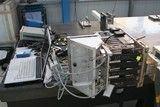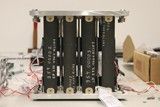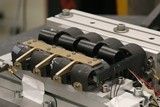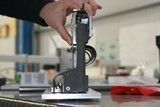
-
StatusCompleted
-
Status date2009-04-21
The Ultra Light Mechanism for Advanced Antenna Systems (ULMAAS) is an elastic collapsible hinge used for deployment of lightweight antennas. ULMAAS is capable of guiding deployment while providing a rotation angle of up to 90 degrees.
The necessary energy for deployment is stored within curved tape springs which are buckled and folded into stowed position. The deployment is triggered by release at the hold down points of the deployable appendage.
The resulting hinge integrates several functions (deployment motorization, guidance, latching and pointing stability) in a compact design weighing less than 0.6 Kg.
The main objective of this study is to develop, manufacture and characterise one Engineering Model of an ultra light deployment mechanism based on purely elastic/collapsible hinges concept made of advanced high performance materials.
The deployment mechanism to be developed shall be suitable for at least C-Ku band antenna reflectors from 1.5 to 3 meters diameter.
The design shall be an optimised configuration of pure structural elements. The hinge shall deploy, position and latch, from the stowed to the operational position in orbit, antenna reflectors with satisfactory performances. As a baseline, only passive concepts, i.e. without any active or semi-active deployment control and regulation features, shall be addressed.
The mechanism complies with most of the requirements but shows two main shortcomings:
- A high variation of torque vs deployment angle with high values at start and end of deployment and a minimum around 8-15°.
- High creeping of the resin with subsequent loss of curvature during accelerated aging at 60°C.
The variation in torque limits the use of ULMAAS due to the motorization margin requirements. The creeping limits the storage lifetime of ULMAAS.
Potential solutions are:
- Use of different length pairs to minimize torque variation,
- Change of matrix system or cure cycle to minimize thermal aging.
New characteristics with respect to similar mechanisms are a complete guidance without friction pairs combined with a high pointing stability (0.01° half cone). No additional latching or actuating elements are needed.
A performance specification was written to guide the development of the mechanism. Some of the key performance features are:
- Mechanism can deploy an antenna payload with 2.2 m diameter and a mass density of 2.2 Kg/m2,
- Mass does not exceed 0.55 kg,
- Occupied volume in the folded configuration does not exceed 140 x 200 x 80 mm3,
- Deployed stiffness exceeds 2 Hz,
- Position accuracy at end of life is better than 0.01° half cone,
- Latching shock on the payload does not exceed 100 N·m.
The development started with a survey covering comparable deployable mechanisms of the last 40 years. A target specification was written based on inputs of antenna manufacturers and a baseline concept selected.
The following steps were the trade-off on materials and geometry, simulations, and functional testing using a breadboard. Verification of the mechanism performance used an antenna dummy in a test campaign which included multiple deployments after a launch vibration test and thermal cycling in order to gauge repeatability of deployment kinematics and reliability of end position.
An accelerated aging test was performed to gauge storage lifetime.
The development programme has ended. The ULMAAS hinge fulfilled the specified operational requirements. It is capable to deploy and latch with high accuracy an inertia dummy, with comparable properties to a reflector antenna in operational position. The hinge provides varying positive deployment torque over its angular travel. Latching is possible when starting the movement from different angular positions.
Achievements:
- An estimated TRL (Technology Readiness Level) of 5 achieved,
- The deployment dynamics were successfully simulated,
- The ULMAAS hinge allowed operation and handling under 1g environment,
- Potential uses for ULMAAS outside space have been identified,
- An efficient damping system was designed and tested,
- ULMAAS has been presented at two major mechanism Symposia: ESMATS and AMS,
- The mechanism has been awarded German and European patents, DE102007026452A1 and EP000002000407A2, respectively.
The design cannot progress unless it is integrated to an antenna program. The recommendations are:
- Increased testing of the ULMAAS present design to overcome observed shortcomings and reinforce the TRL 5-6,
- Incorporation of ULMAAS into an antenna programme to reach TRL7-9.
Designs of ULMAAS to reach angles greater than 90° are being explored. Commercialization in aerospace and industrial applications for single shot deployment devices is being studied.
 click for larger image |
|
 click for larger image |
 click for larger image |





